Selbstbau Mono 8x30Dieser Bausatz für ein 8x30 Prismenmonokular wurde in Deutschland ca. in den 60er Jahren hergestellt. Auf der Verpackungsschachtel lässt sich kein Hinweis auf den Hersteller findne - es könnte von eienr Firma wie "Krombahc" oder "Geller", aber evtl. auch von Zeiss in Jena vertrieben worden sein.Der 400g schwere Karton (280x207x58mm) beinhaltet alle Einzelteile sowie die Teileliste in der Deckelinnenseite. Eine Bauanleitung liegt nicht vor. Der Deckel ist oben mit "Bau dir dein Fernglas selbst", "Qualitäts-Prismengläser - Monokulare Ausführung, Deutsche Wertoptik - Deutsches Gebrauchsmuster angemeldet" und unten mit "Do it yourself - a compelte kit of parts for self-mounting of a high-quality monouclar field-glas, Lenses and prism of outstanding quality - Made in Germany" beschriftet. Abgebildet sind zwei Monokulare: eines wie im Bausatz vorgeshen mit kurzem Objektivtubus, eines mit langem Objektivtubus – vermutlich gabe es also auch einen Bausatz für ein 7x30 oder 7x50 Glas. Im Kasten rechts unten ist die rote Stempelung "8x30". |
Do it yourself Mono 8x30THis building kit for a 8x30 prism monocular was made in Germany in about the '60s. The cardboard case gibes no informatiuon about the maker – it might come from firms like "Krombach" or geller", but could also be aCarl ZeissJena (GDR) product.The 400g box (280x207x58mm) conatins all parts as well as a list of parts inside the case lid. There is no manual left over. The lid is inscribed at the upper part "Bau dir dein Fernglas selbst", "Qualitäts-Prismengläser - Monokulare Ausführung, Deutsche Wertoptik - Deutsches Gebrauchsmuster angemeldet" and at the lower part "Do it yourself - a compelte kit of parts for self-mounting of a high-quality monouclar field-glas, Lenses and prism of outstanding quality - Made in Germany". Two monocular versions ar depicted on the cover: one wiuth a short objective tube such as this kit, and another one with a long objective tube, probably a 7x30 or 7x50 monocular. A framed "8x30" red stamp denotes the specifications of the monocular in this box. |
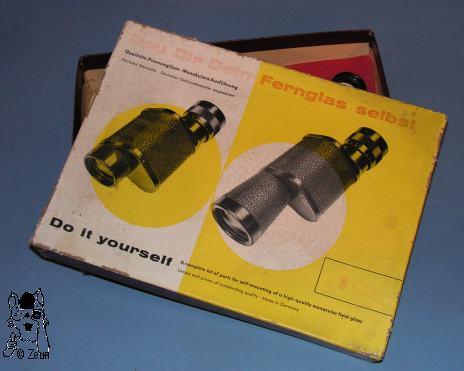
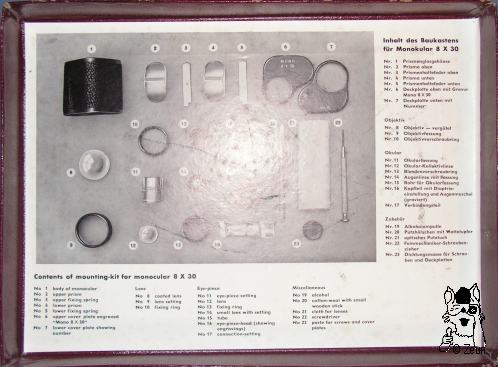
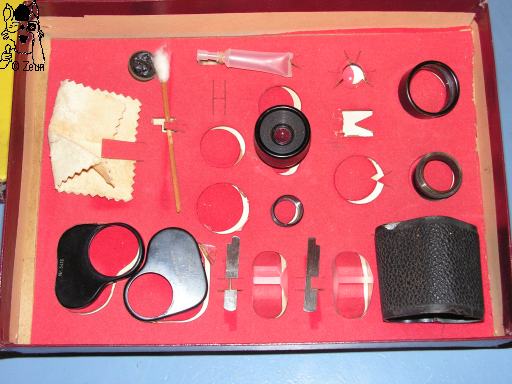
| Das Monokular hat vergütete Linsen, eine Kunststoffummantelung um das Alugehäuse mit eingegossener Trageöse. Die Deckel sind schwarz lakciert und nciht verschraubt, sondern werden durch den Okular- und Objektivtubus gehalten. Das rechtsseitige Okular hat eine Plastikaugenmuschel und eine Dioptrieskala von plus bis minus Vier und Markierungen mit "0" sowie "+" und "-". | The monocular has coated lenses, a plastic covering at the aluminium housing with its cast-in strap lug, and black painted cover plates. The latters have no screws but are held by the ocular and objective tubes. The right-hand sided ocular has a plastic eyecup and a dioptre scale ranging from plus to minus four, being marked with "0", + and -. |
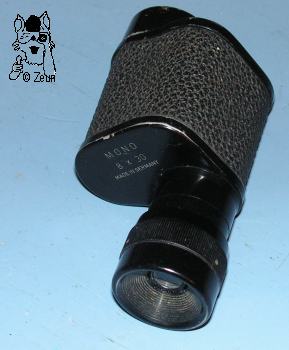
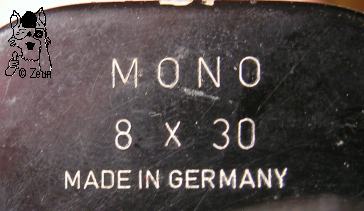
| Das zusammengesetzte Monokular wiegt 208 Gramm. Es ist 110-117mm lang, das Gehäuse oben 51x51mm und unten 53x53mm breit. Der Okulartubus ist 28mm, die Augenmuschel 34mm und der Objektivtubs 35mm im Durchmesser. Der obere Deckel ist mit "MONO 8x30 Made in Germany", der untere Deckel mit "Nr. 5416" gekennzeichnet. |
The assembled monocular weighs 208g. It is 110-117mm tall, the housing measures 51x51mm at its top, and 53x53mm at its bottom. The ocular tube's diameter is 28mm, the one of the eyecup 34mm, and the objective tube is 35mm in diameter. The top cover plate is marked "MONO 8x30 Made in Germany", the bottom one bears "Nr. 5416", |
Fotos: Zeun

